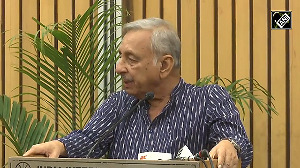Deepak Mahurkar
Associate Director - Oil & Gas
PwC
The fundamentals of demand and supply will prevail in the medium to long term, resulting in a self-price-correction mechanism. The former Federal Reserve Chairman, Alan Greenspan, recently said, "I think we are clearly on the edge of recession, placing the odds at 50 per cent or better. High oil prices are a burden now." Saudi Aramco feels that oil prices have been buffeted by the combination of relatively healthy demand, concerns for supply interruptions, stretched refining capacity, world and regional events, and a continued debate about the role of financial speculation in oil price volatility.
Further, the effects of sub-prime debt problem have rippled through global markets, risking global economic growth and creating uncertainty for the oil market in general and oil demand in particular. In addition, volatility among key world currencies has confused the situation further.
Oil has been traded globally for more than a century, and commodity pricing in the oil sector is well-established. Crude oil prices behave much as any other commodity with wide price swings in times of shortage or oversupply. The crude oil price cycle may extend over several years responding to changes in demand as well as OPEC and non-OPEC supply.
In the short term, the movements in crude oil price are influenced by geopolitical events, movement of financial markets, expectations and psychology, whereas, in the medium to long run, the fundamentals of demand and supply (production capacity) will prevail, resulting in a self-price-correction mechanism.
The vulnerability of oil-importing countries to higher oil prices varies. Studies have indicated that a sustained increase of $10 in the crude oil price would reduce economic growth in the OECD as a whole by up to 0.5 per cent. The impact on growth in developing countries is thought to be significantly higher, because energy-intensive manufacturing generally accounts for a larger share of their GDP.
Since 2002, major oil producing countries have gained confidence to invest in exploration and development. Furthermore, planned gross capacity additions from new projects in non-OPEC countries (including non-conventional sources such as oil sands and gas-to-liquids) would add to supply. The development of technology and rising prices have made non-conventional oil production economic, such as the Canadian tar sands, now producing about one million barrels per day (mbpd), as well as production from deep and ultra-deep offshore locations. These capacity additions would outstrip the expected demand growth of about 9.4 mbpd over the same period.
Markets worry about a worsening US economy that could hit demand. Oil-consuming countries have also started diversifying their fuel-mix by switching to alternative sources of energy like natural gas and renewables. The interplay of these forces would drive down the prices of crude oil from the current levels.
The Energy Information Administration has projected crude oil price to average $94 per barrel in 2008 and ease somewhat to about $86 per barrel in 2009. The crystal ball of many planners would actively gaze, but recent developments indicate high oil prices will not be sustainable and will drive down. Energy technologists are hopeful that high prices would drive the world to develop alternative technologies and, in the mid term, become the cause of reduction.
Raju Lal
Partner, Ernst & Young
Rising geopolitical uncertainty, a falling dollar and the growing speculative interest in commodities trading will keep crude prices volatile.
Current crude prices which have crossed $110 a barrel are nearly 10 times the levels less than a decade ago. Crude oil futures prices for delivery until 2016 have also moved above $100 a barrel. This is a clear indication that high crude oil prices are here to stay as investors bet that oil prices will remain high in the long term. The sustained northward movement of the prices points towards some fundamental changes in the market.
On the demand side, while consumption in the past has been driven by OECD countries, particularly the US, much of the current incremental demand is coming from emerging economies, particularly China and India, which contributed more than 40 per cent of the incremental global consumption during 2000-06. Global oil demand is expected to increase to 100 million barrels per day (mbpd) by 2015 as against 85.7 mbpd currently.
While oil demand is projected to increase significantly, supply may struggle to keep pace. The production from the existing fields is declining by 4 per cent per annum which means that that around three mbpd of new capacity needs to be added every year just to offset the decline in existing production. In order to meet the demand projections of 100 mbpd, the annual supply increment requirement would be 7 mbpd by 2015 (the average annual increment rate during 1971-2006, considering a 4 per cent decline, was 3.5 mbpd).
The majority of the incremental supplies would have to be contributed by major OPEC reserve holders such as Saudi Arabia, Venezuela, Iran, Iraq and Nigeria. The emerging geopolitical dynamics continues to raise concerns about the ability of these countries (other than Saudi Arabia) to raise production significantly. In addition, the growing mismatch between the incremental nature of crude from Saudi Arabia (heavier and sour) and the growing demand for lighter products is expected to exert further pressure on the refining capacity which is already strained, resulting in greater price volatility.
Going forward, a significant portion of the incremental production is expected to be contributed from frontier, deepwater and unconventional sources, which are expected to be brought on-stream at higher prices, particularly in light of the increase in the prices of upstream equipment and services.
The depreciation of the US dollar is also held as one of the culprits for the price rise as it encourages global consumption to some extent by shielding foreign buyers from the full impact of the increase in prices. The falling dollar coupled with the declining stock and credit markets also increases traders' interest in commodities such as oil and gold, which further fuels price rise.
Speculative investment by major hedge funds also seems to play a key role on oil price volatility. While, one cannot rule out the possibility of the volatile crude prices from receding somewhat in the near future, driven maybe by a dip in global demand as a result of sustained economic downturn in the US, what does appear is that over the last few years, the equilibrium price of oil has shifted upwards and the volatility has increased significantly, leaving prices vulnerable to fluctuations even due to the slightest disruption in supplies or changes in demand.








 © 2025
© 2025